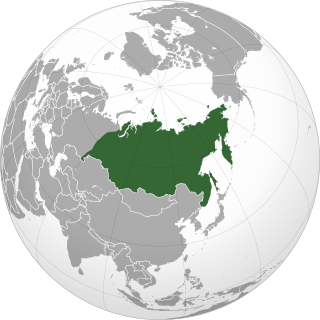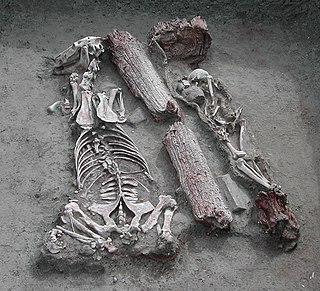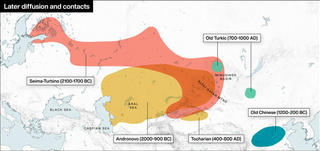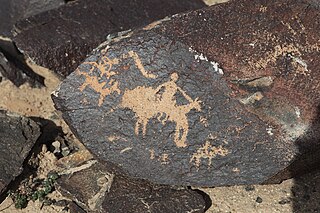
Siberia is an extensive geographical region comprising all of North Asia, from the Ural Mountains in the west to the Pacific Ocean in the east. It has formed part of the sovereign territory of Russia and its various predecessor states since the centuries-long conquest of Siberia, which began with the fall of the Khanate of Sibir in the late 16th century and concluded with the annexation of Chukotka in 1778. Siberia is vast and sparsely populated, covering an area of over 13.1 million square kilometres (5,100,000 sq mi), but home to only one-fifth of Russia's population. Novosibirsk and Omsk are the largest cities in the area.

The Pazyrykburials are a number of Scythian (Saka) Iron Age tombs found in the Pazyryk Valley and the Ukok plateau in the Altai Mountains, Siberia, south of the modern city of Novosibirsk, Russia; the site is close to the borders with China, Kazakhstan and Mongolia.
The Afanasievo culture, or Afanasevo culture, is an early archaeological culture of south Siberia, occupying the Minusinsk Basin and the Altai Mountains during the eneolithic era, c. 3300 to 2500 BCE. It is named after a nearby mountain, Gora Afanasieva in what is now Bogradsky District, Khakassia, Russia. Afanasievo burials have been found as far as Shatar Chuluu in central Mongolia, confirming a further expansion about 1,500 km beyond the Altai mountains. The Afanasievo culture is now considered as an integral part of the Prehistory of Western and Central Mongolia.

Vladimir Afanasyevich Obruchev was a Russian and Soviet geologist who specialized in the study of Siberia and Central Asia. He was also one of the first Russian science fiction authors.

The Manchurian wapiti is a subspecies of the wapiti native to East Asia.

Deer stones are ancient megaliths carved with symbols found largely in Siberia and Mongolia. The name comes from their carved depictions of flying deer. There are many theories to the reasons behind their existence and the people who made them. The Deer stones are part of a pastoral tradition of stone burial mounds and monumental constructions that appeared in Mongolia and neighbouring regions during the Bronze Age. Various cultures occupied the area during this period and contributed to monumental stone contructions, starting with the Afanasievo culture, and continuing with Chemurchek, Munkhkhairkhan or Ulaanzuukh traditions. The Deer stones themselves belong to one of the latest traditions of monumental stones, from circa 1300 to 700 BCE, but precede the Slab grave culture.

Kurgan stelae or Balbals are anthropomorphic stone stelae, images cut from stone, installed atop, within or around kurgans, in kurgan cemeteries, or in a double line extending from a kurgan. The stelae are also described as "obelisks" or "statue menhirs".

The Prehistory of Siberia is marked by several archaeologically distinct cultures. In the Chalcolithic, the cultures of western and southern Siberia were pastoralists, while the eastern taiga and the tundra were dominated by hunter-gatherers until the Late Middle Ages and even beyond. Substantial changes in society, economics and art indicate the development of nomadism in the Central Asian steppes in the first millennium BC.
Glazkov culture is an archaeological culture of possibly proto-Tungusic tribes in the Bronze Age, spread in the Baikal area.
Various nomadic empires, including the Xiongnu, the Xianbei state, the Rouran Khaganate (330–555), the First (552–603) and Second Turkic Khaganates (682–744) and others, ruled the area of present-day Mongolia. The Khitan people, who used a para-Mongolic language, founded an empire known as the Liao dynasty (916–1125), and ruled Mongolia and portions of North China, northern Korea, and the present-day Russian Far East.

The Seima-Turbino culture, also Seima-Turbinsky culture or Seima-Turbino phenomenon, is a pattern of burial sites with similar bronze artifacts dated to c. 2300–1700 BCE found across northern Eurasia, particularly Siberia and Central Asia, maybe from Fennoscandia to Mongolia, Northeast China, Russian Far East, Korea, and Japan. The homeland is considered to be the Altai Mountains. These findings have suggested a common point of cultural origin, possession of advanced metal working technology, and unexplained rapid migration. The buried were nomadic warriors and metal-workers, traveling on horseback or two-wheeled carts.

The nations which make up Central Asia are five of the former Soviet republics: Kazakhstan, Kyrgyzstan, Turkmenistan, Tajikistan and Uzbekistan, which have a total population of about 76 million. Afghanistan is not always considered part of the region, but when it is, Central Asia has a total population of about 122 million (2016); Mongolia and Xinjiang is also sometimes considered part of Central Asia due to its Central Asian cultural ties and traditions, although geographically it is East Asian. Most central Asians belong to religions which were introduced to the area within the last 1,500 years, such as Sunni Islam, Shia Islam, Ismaili Islam, Tengriism and Syriac Christianity. Buddhism, however, was introduced to Central Asia over 2,200 years ago, and Zoroastrianism, over 2,500 years ago.

The Slab-Grave culture is an archaeological culture of Late Bronze Age and Early Iron Age Mongolia. The Slab-Grave culture formed one of the primary ancestral components of the Xiongnu, as revealed by genetic evidence. The ethnogenesis of Turkic peoples and the modern Mongolian people is, at least partially, linked to the Slab-Grave culture by historical and archaeological evidence. and further corroborated by genetic research on the Slab Grave remains.
The Altai-Sayan region is an area of Inner Asia proximate to the Altai Mountains and the Sayan Mountains, near to where Russia, China, Mongolia and Kazakhstan come together. This region is one of the world centers of temperate plant diversity. Its biological, landscape, historical, cultural and religious diversity is unique. 3,726 species of vascular plants are registered in the region including 700 threatened or rare species, 317 of which are endemic; fauna consists of 680 species, 6% of which are endemic. Its ecosystem is comparatively unchanged since the last ice age, and it is the host of endangered species that include the saiga, nerpa, and snow leopard. It is the focus of ongoing international and regional environmental conservation initiatives.

The Steppe Route was an ancient overland route through the Eurasian Steppe that was an active precursor of the Silk Road. Silk and horses were traded as key commodities; secondary trade included furs, weapons, musical instruments, precious stones and jewels. This route extended for approximately 10,000 km (6,200 mi). Trans-Eurasian trade through the Steppe Route preceded the conventional date for the origins of the Silk Road by at least two millennia.

The Altai alpine meadow and tundra ecoregion is a terrestrial ecoregion covering the higher elevation of the Altai Mountains at the center of the "X" formed by the borders separating Russia, Kazakhstan, China, and Mongolia. The mountain peaks are the farthest north in Central Asia, separating the plains of Siberia to the north from the hot, dry deserts to the south. Altitudes above 2,400 meters display characteristics of tundra, with patches of alpine meadows and some trees immediately below the treeline. The ecoregion is in the montane grasslands and shrublands biome, and the Palearctic realm, with a humid continental climate. It covers an area of 90,132 square kilometres (34,800 sq mi).

Yinshan Rock Paintings or Rock Paintings of Yinshan Mountains, also known as Petroglyphs in the Yinshan Mountains or Rock Paintings of Yinshan Mountain, are images carved into the rocks of the Yin Mountains and are widely distributed, mainly on the cliffs of Wolf Mountain in the Inner Mongolia, with themes involving animals, figures, deities, artifacts, celestial bodies.

Content in this edit is translated from the existing Russian Wikipedia article at ru:Чебаки (крепость); see its history for attribution

In archaeogenetics, the term Ancient Northeast Asian (ANA), also known as Amur ancestry, is the name given to an ancestral component that represents the lineage of the hunter-gatherer people of the 7th-4th millennia before present, in far-eastern Siberia, Mongolia and the Baikal regions. They are inferred to have diverged from Ancient East Asians about 24kya ago, and are represented by several ancient human specimens found in archaeological excavations east of the Altai Mountains. They are a sub-group of the Ancient Northern East Asians (ANEA).





















